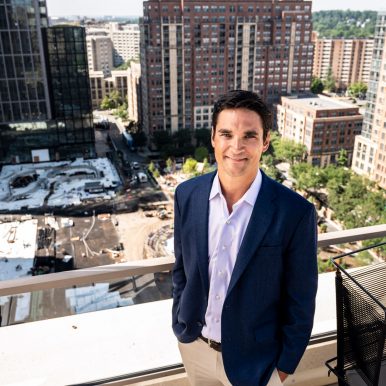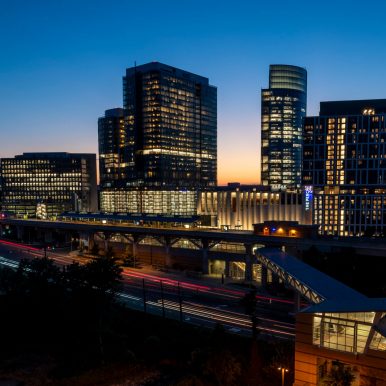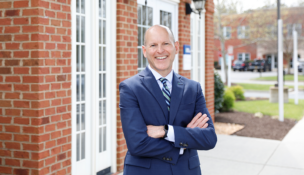Creating community vibes
Placemaking focuses on people and design
In Virginia Beach, most tourists flock to the Oceanfront. But just a couple blocks west, you’ll find an area that feels a little more artsy and a lot more local.
In the 15-block ViBe Creative District, situated between the Virginia Beach Convention Center and the Oceanfront, coffee shops and restaurants operate out of former industrial spaces, alongside fences and crosswalks decorated with colorful murals.
Local business owners started discussing the need for creating a unified district around 2011. Over the next few years, the effort grew. By 2015, Virginia Beach City Council passed an ordinance establishing the ViBe as the city’s official creative district. What was once an underdeveloped and rundown industrial area — a place that was “not for people,” as one longtime resident puts it — has blossomed into a cultural mecca with trendy shops and weekend farmers markets.
Kate Pittman, executive director of the nonprofit ViBe Creative District organization, which supports and promotes the district, says the district’s founders deliberately planned for it to become the “No. 3 destination” in Virginia Beach, behind the Oceanfront and the upscale Town Center, a mixed-use district with a blend of retail, restaurants, hotels and office towers.
“The ViBe district is something that has very much that local flavor and really is the kind of locals’ opportunity to win and live the life of their dreams in their own hometown,” she says. “So, for us, we think it’s a beautiful asset [for] tourism because while [tourists are] here in Virginia Beach exploring the Oceanfront, they can come inland just a few blocks and get to meet and see local business leaders and local artists engaging in beautifying Virginia Beach and making it just something new and different and really enriching.”
The ViBe district’s creation was no coincidence. It’s a primary example of placemaking — a term developers use to describe the purposeful development of people-centric public spaces and districts. Placemaking is defined by vibrant, transit-oriented walkable neighborhoods and a mix of retail, offices, residential and even hotels.
From farm to metropolis
Placemaking is more than just physical buildings or a design philosophy, says Juanita Hardy, managing principal of Silver Spring, Maryland-based Tiger Management Consulting Group LLC and a former senior visiting fellow for creative placemaking at the Urban Land Institute. It’s about what goes on around a development, including parks, public art and events programming — everything that attracts people to spend time in an area.
While there are multiple ways of interpreting it, placemaking in Virginia dates back at least 60 years, when developers had a vision for the transformation of Tysons Corner. What had once been a rural crossroads marked by farms and a mom-and-pop gas station has grown into a thriving edge city lauded by planners and developers as one of the nation’s premier examples of placemaking.
Now known as simply Tysons, it evolved from office parks and a sprawling shopping mall into a budding metropolis that is now home to corporate headquarters for Fortune 500 companies such as Freddie Mac, Capital One Financial Corp., Hilton Worldwide Holdings Inc. and Booz Allen Hamilton Inc.
Tysons “represented something new and profoundly different for Fairfax and all of the suburbs,” says Terry Clower, a professor of public policy at George Mason University and director of Mason’s Center for Regional Analysis.
Featured in the 1991 book “Edge City: Life on the New Frontier,” by Joel Garreau, Tysons forged the way for the success of other planned communities and developments.
“I don’t think Reston could have happened without the success of Tysons,” Clower says, referring to the similarly successful Fairfax County community that also began as a planned development in the 1960s and has now grown into a nearly 16-square-mile district featuring suburban neighborhoods, corporate office towers and the mixed-use Reston Town Center.
While placemaking is hardly a new trend, the idea of placemaking as an economic development panacea and redevelopment tool has gained popularity, with local governments even creating positions to support it.
“In conversation after conversation with business executives, we hear that a sense of place is paramount,” says Anthony Romanello, executive director of the Henrico County Economic Development Authority, which appointed a dedicated placemaking manager this year. “Creating workplaces that are attractive, fun, walkable and engaging is as essential to economic development as low taxes, good roads, quality schools and a pro-business climate.”
Virginia offers a variety of examples of placemaking in different stages of development, ranging from billion-dollar projects in the planning stages to mature communities like Tysons.
Changing identities
In Arlington County, a new neighborhood, National Landing, is rising around Amazon.com Inc.’s $2.5 billion-plus HQ2 East Coast headquarters.
Bethesda, Maryland-based JBG Smith Properties, the real estate company developing HQ2 and the surrounding area, is aiming to create a “vibrant, transit-oriented, walkable” neighborhood there, “with ground-floor retail and a mix of uses,” says company Vice President Jack Kelly.
National Landing encompasses three older neighborhoods: Potomac Yard (straddling the Alexandria-Arlington line), Crystal City and Pentagon City (both in Arlington). In decades past, these were largely business districts that emptied out at the end of the day, encouraging car-centric commuting back and forth from the suburbs. But local economic developers and JBG Smith are hoping to unite them under the National Landing moniker as one downtown district — a place where people can live, work and play.
The late 2018 announcement that HQ2 was coming to Arlington presented the opportunity for a “big shift in our planning and development … to move toward good urbanism,” says Tracy Gabriel, president and executive director of the National Landing Business Improvement District (formerly known as the Crystal City Business Improvement District).
Amazon HQ2 will have about 4.9 million square feet of office space, divided across two phases: Metropolitan Park, the first phase, is set to open in 2023, with two 22-floor office towers, a 2-acre public park and 65,000 square feet of ground floor retail. The second phase, PenPlace, slated to open in 2025, includes plans for three additional 22-story towers. It’s also expected to feature HQ2’s centerpiece, the distinctive, 354-foot-high spiral-shaped Helix building.
But more than that is planned for National Landing.
“Everything we do is rooted in that idea that we’ve got a big opportunity to really change the identity of a place that’s been around a long time,” Kelly says.
That means creating public spaces where people can gather, as well as adding design elements to create a sense of continuity in the neighborhood. “It’s really all about that civic space,” he says, “identifying those areas that are meaningful to the community … and then creating a landscape and streetscape that is attractive and unifying … across large areas.”
While National Landing is already well underway to fulfilling its vision of becoming a new community, other placemaking projects in Virginia are in earlier stages.
In Henrico County, developers are preparing to redevelop the former Best Products Co. corporate headquarters campus, which closed in 1997, into GreenCity, a $2.3 billion, 200-acre mixed-use “ecodistrict” that will include an up-to-17,000-seat multipurpose arena; two or three hotels; about 2,200 housing units; and 2.2 million square feet of office space.
Developers Susan Eastridge and Michael Hallmark brought the privately funded GreenCity project to Henrico after a similar, publicly funded project they pitched to Richmond, the $1.5 billion Navy Hill development, failed to receive support from Richmond City Council.
Henrico’s government has embraced GreenCity, which was announced in December 2020 and approved for rezoning by the Henrico County Board of Supervisors less than 10 months later. GreenCity’s full buildout will take 10 to 12 years, says Eastridge, CEO of Fairfax-based Concord Eastridge Inc. Construction is expected to begin by late 2023 or early 2024.
One of the core components of the project is the arena, which developers hope will attract major sporting and entertainment events. Hallmark, founder of Los Angeles-based Future Cities LLC, has a background in designing arenas. The co-founder of a handful of sports arena architecture firms, he helped lead the design of projects such as Los Angeles’ Crypto.com Arena. He hopes that GreenCity’s status as an ecodistrict — a development focused on environmental sustainability — will draw interest from large music acts that have pledged to make their tours ecologically friendly.
He and Eastridge also anticipate that GreenCity will be a magnet for businesses and residents who care about saving the planet. GreenCity’s sustainability features include devoting more than 20 acres of rooftops for a solar energy farm and harvesting and reusing rainwater.

Places in the pipeline
Around the commonwealth, placemaking can also be seen in the planning and creation of new buzzworthy downtown districts. Examples range from Norfolk’s Military Circle Mall redevelopment and Richmond’s Diamond District to Chesapeake‘s Summit Pointe.
Norfolk is in early negotiations with developers, including music icon and Virginia Beach native Pharrell Williams, to redevelop the old Military Circle Mall property into Wellness Circle, a proposed $1.1 billion mixed-use community with 1 million square feet of office space, a 200-room hotel, 1,100 new housing units and a 15,000-seat arena. The project’s other developers include Virginia Beach-based Venture Realty Group and California arena management company Oak View Group. (Two other development teams, including groups connected with Virginia Beach hotelier Bruce Thompson and Pro Football Hall of Famer Emmitt Smith, submitted competing proposals for the project.)
In nearby Chesapeake, Fortune 500 discount retailer Dollar Tree Inc. is developing a downtown district around its 12-story corporate headquarters built in 2018. The $300 million Summit Pointe development is expected to have 1 million square feet of office space, 500,000 square feet of retail and 1,400 residences when all 70 acres are fully built out.
In 2018, Chesapeake Mayor Rick West described Summit Pointe as “the beginning of a new downtown Chesapeake.”
That’s how Chris Williams, a senior vice president with Dollar Tree and its Summit Pointe Realty subsidiary, sees it, too.
“There really isn’t a place [like this] in Chesapeake, so I think between the restaurant and the residential spaces we are building, it gives the community a place to come and enjoy,” says Williams, who now sees people in Summit Pointe gathering at Wasserhund Brewing Co. in the evenings or jogging around the streets. “It really becomes a community.”
Another district primed for placemaking is the area around the Diamond, the aging stadium that’s home to Richmond’s Minor League Baseball team, the Flying Squirrels. The city wants to build a new baseball stadium as the centerpiece of a new, pedestrian-friendly residential, business and entertainment district. It’s planned for a 67-acre site that currently includes the stadium and underdeveloped properties alongside Interstates 64 and 95, not far from the popular Scott’s Addition neighborhood. Three teams have submitted competing redevelopment proposals. The city’s evaluation panel was expected to recommend a developer in late July to Richmond City Council, which would have to approve the development agreement.
Good ViBes
While National Landing, GreenCity and other places are in earlier stages of development, Virginia Beach’s ViBe Creative District, which has been around for about seven years, is blossoming.
After the city redeveloped the convention center in 2005, there wasn’t anything nearby to attract convention-goers — just lots of vacant storefronts and industrial properties. “There was a real need to … breathe new life into this area,” says Pittman with the ViBe’s nonprofit booster organization.
In response to that problem, local business owners Laura Wood, whose family owns Croc’s 19th Street Bistro, and Andrew Fine, co-chairman of The Runnymede Corp., came up with the idea for the ViBe, rallying businesses and property owners to develop the community.
Together, Wood and Fine co-founded the ViBe. Working with the city and the Hampton Roads Community Foundation, they were able to launch the nonprofit group and hire Pittman in 2016. The nonprofit, which has raised more than $1 million since its founding, has evolved into an entity that is able to collaborate with the city’s economic development office to create a matching grant program for the district’s small businesses.
Today, the ViBe has a coworking space, restaurants and artsy shops, and hosts bustling flea markets and farmers markets during weekends.
The ViBe’s nonprofit developed a cohesive identity for the ViBe by engaging local artists to produce an array of colorful neighborhood identifiers such as fence murals and brightly painted street meters, signaling the district’s emphasis on creativity.

“Creative placemaking through art supports a triple bottom line for sustainable communities and creative energy enhanced by creative arts,” says Wood, and that translates into economic benefits, health and environmental benefits, and social cohesion.
“We believed these creative and public art spaces must be discovered, seen, felt, heard, tasted, smelled and touched,” Wood says. “It could be explored on fence walls, streets, sidewalks, parking lots, open spaces and gardens, alleyways and buildings. I saw a blank canvas for ViBe and the 19th Street corridor via the Old Beach Farmers Market to create a heartbeat in our neglected neighborhood that could be filled with authentic local food, farmers, spaces with paint, native gardens and an environmentally friendly, artful soul and emotion to entice, with creative opportunities to be discovered.”
Another integral figure in the ViBe’s development is L.G. Shaw, president of Wave Riding Vehicles, a Virginia Beach-based retailer and manufacturer of surfboards and sporting apparel and goods.
Growing a community is not a new concept to Shaw. “Being surfers first, we’ve always had to build our own sort of clubhouse and community here in Virginia Beach,” he says. “Surf shops have always been a placemaking headquarters on accident — that’s where [surfers] went back in the day.”
WRV had unused warehouse spaces around the district, so Shaw decided to lease the spaces to “cool little artistic” businesses like North End Bag Co., where shoppers can buy handbags made by hand right on premises. Nearby, Igor’s Custom Signs & Stripes makes hand-painted signs, banners and murals, and Jars of Dust makes and sells handcrafted ceramics carried by national retailer Anthropologie.
More than 50 businesses have opened or expanded operations in the ViBe since 2015, and real estate values within the district rose by more than $45 million collectively between 2015 and 2021.
It shouldn’t come as a surprise, then, that other developers are hoping to capture some of the ViBe’s vibe.
“I think the ViBe district has organically and authentically evolved into a vision of what Virginia Beach could be,” says Donna MacMillan-Whitaker, managing partner of Venture Realty Group, which is co-developing the nearby
$350 million Atlantic Park with Pharrell Williams. “We want to expand on and help anchor that.”

In its first phase, set to break ground in October, the Atlantic Park project, which will be about three blocks from the ViBe, calls for a 2-acre, manmade wave lagoon, 120,000 square feet of retail, 310,000 square feet of residential living space, 15,000 square feet of office space and a 3,500-seat entertainment venue.
The ViBe was “a true grassroots effort by a passionate and dedicated community group,” MacMillan-Whitaker says. “Look around the country at other successful cities — which cities are expanding, retaining their talented youth, growing their population, their tourism, and even their wages? Art and culture and placemaking are what people want to be a part of.”
t

















